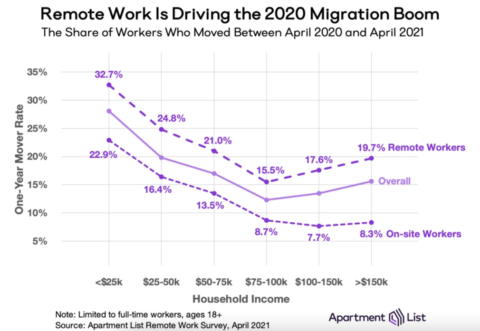The Great Migration: Remote work has people moving again

June 2021 // NAI DESCO Blog
The US has been a ‘low move’ country for a while. The Census Bureau keeps statistics on how many Americans move to new residences each year, and their data shows that the national mover rate has been on the decline for almost 40 years. It peaks at just over 20% in the mid-1980s and has been trending down since. Then came the Covid-19 pandemic and its remote work revolution.
According to a new Apartment List report, published in May 2021, the pandemic has “sparked a rebound in residential migration”. This comes out of their recent remote work survey which drew qualitative comment from some 5000 Americans, and used the US census data, to establish that 16% of Americans moved between April 2020 and April 2021 – “the first increase in migration in over a decade”.
Wealth has legs
The research finds that the largest increase in this residential migration rate over the last year can be seen in high-income households (earning over $150,000) which is particularly interesting as people in this segment have been the least likely to move in the last decade.
Remote workers, specifically, were a whopping 53% more likely to move than on-site workers – making remote work “one of the major drivers in this trend”, a trend they expect to “remain prevalent even after the pandemic wanes”.
“Wealthy movers in 2020”, the report says, were “more likely to move further from job centers in order to buy homes, enjoy more physical space, and live in places with lower cost-of-living” as a result of their flexible and high-wage jobs.
Six-figure households, the survey concludes, were “twice as likely to purchase a home” and “more likely to have gained additional physical space” because they are able to put greater distance between themselves and their previous place of work/employer.

Heavy burdens to bear
This is a trend turned on its head, as traditionally wealth and likeliness of moving have had an inverse relationship, where low earners move more often than high earners. In 2010, for example, there was a 27% movers rate among workers with household incomes less than $25 000 – compared to a 9% rate in the segment where household earnings were $150 000 or above.
This data further underlines how the Covid-19 pandemic had a disproportionate effect on low earners. That is not to say that low earners didn’t move in 2020 – they certainly did in droves. We see that this group had a movers rate of 28% according to the survey, and the Apartment List argues these workers moved “in search of more affordable living arrangements” in the face of income insecurity.
Widening divide
While the increase in moving can be seen in a positive light, for the real estate sector and the recovery of suburbs and remote work spots, there is also the worry of a growing divide: what Business Insider calls a K-shaped graph – describing the different trajectory of “professional workers” and “everyone else”, a trend also seen starkly in the millennial generation.